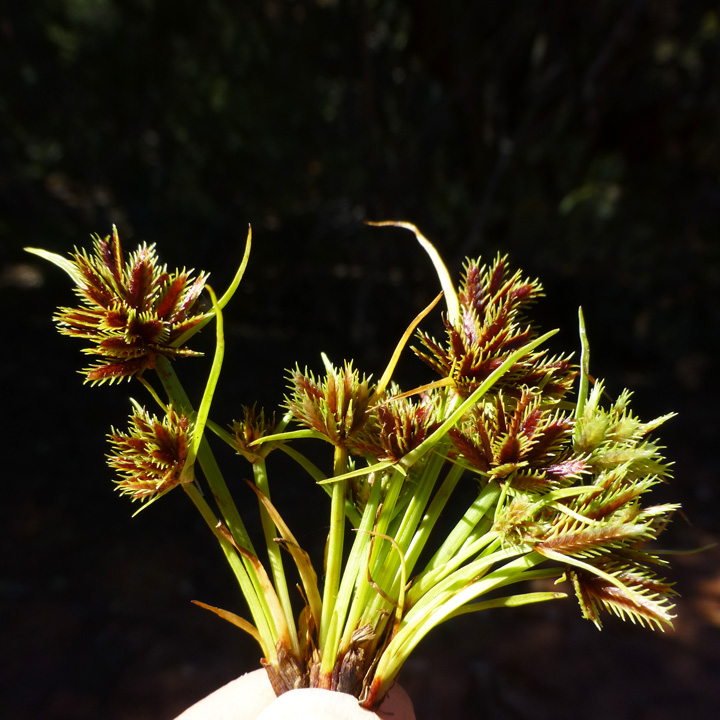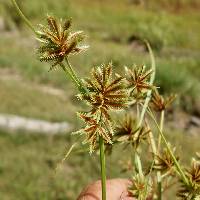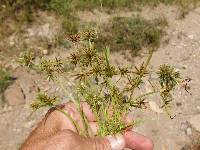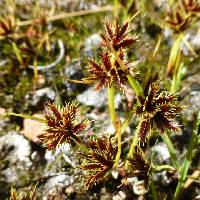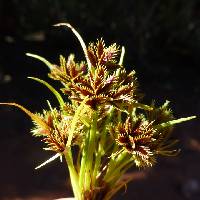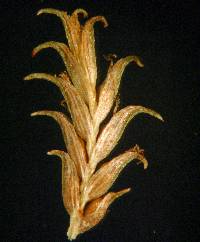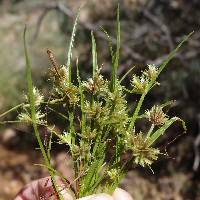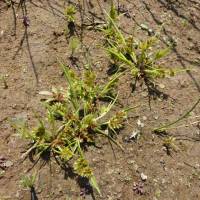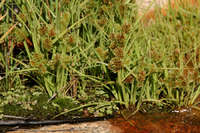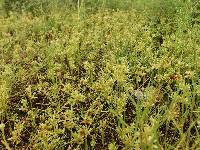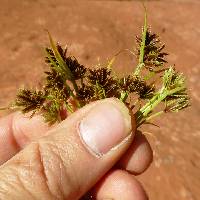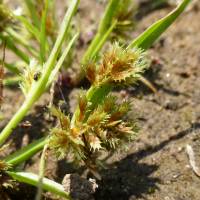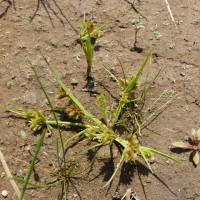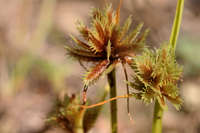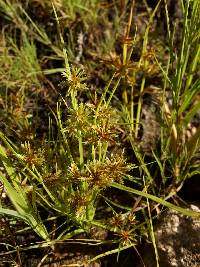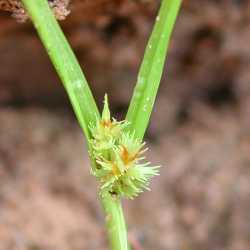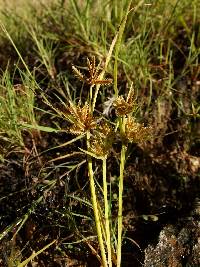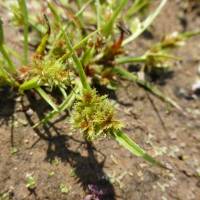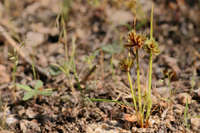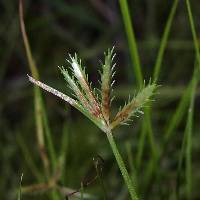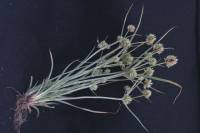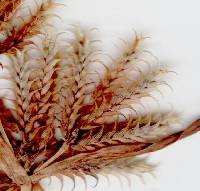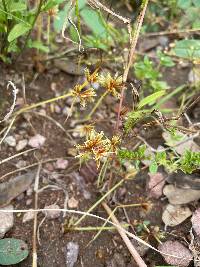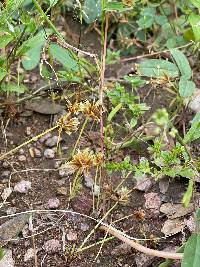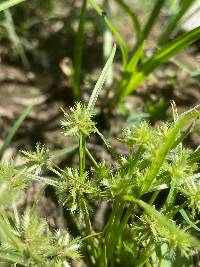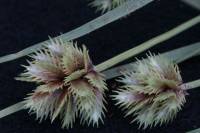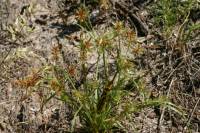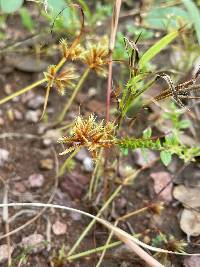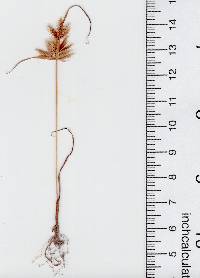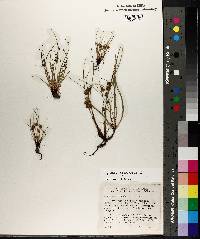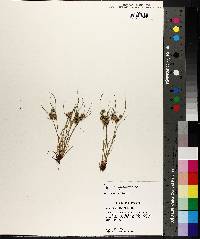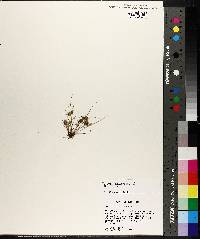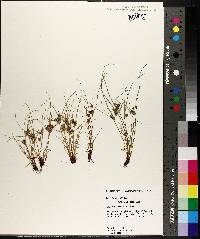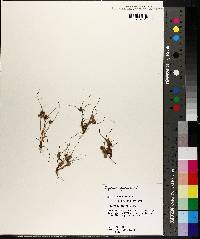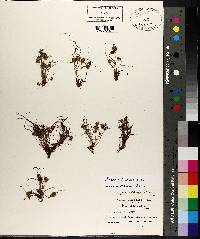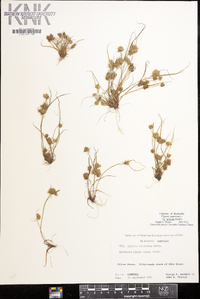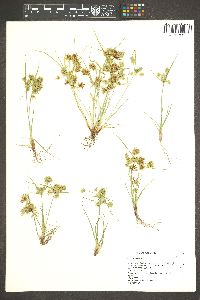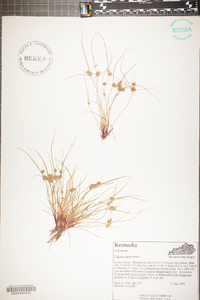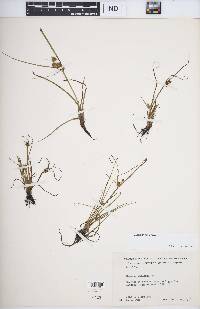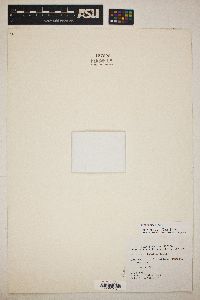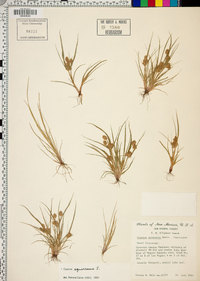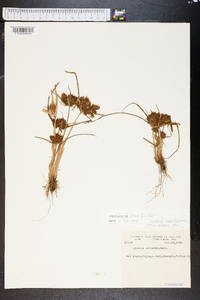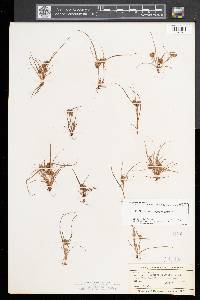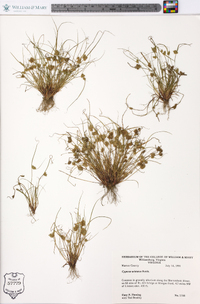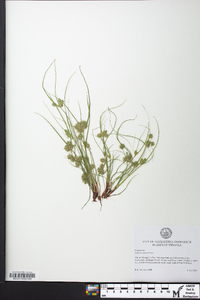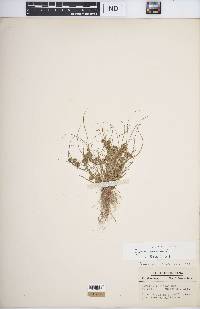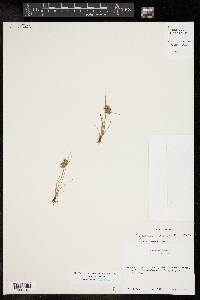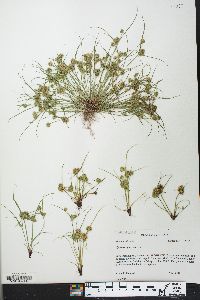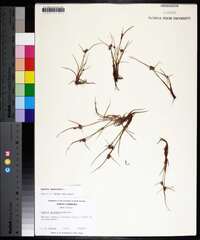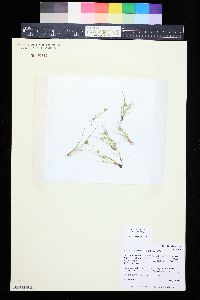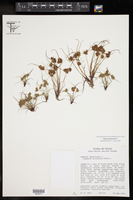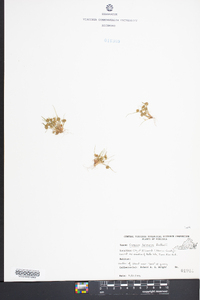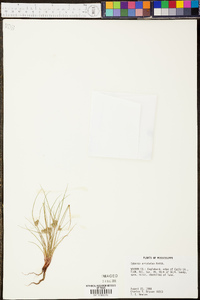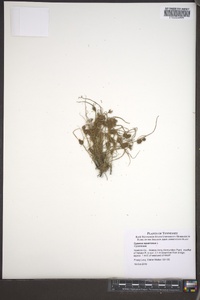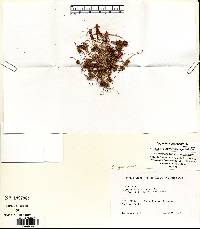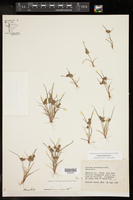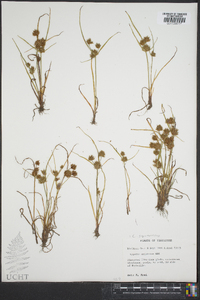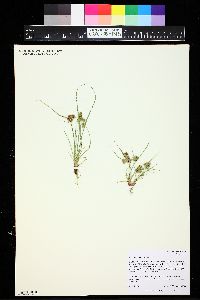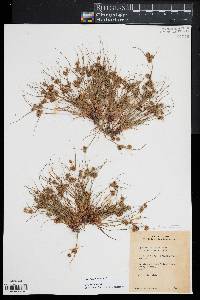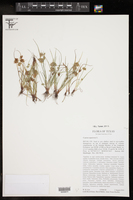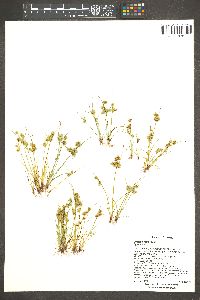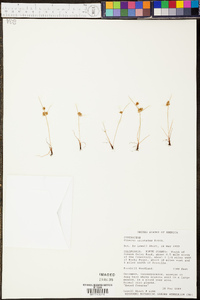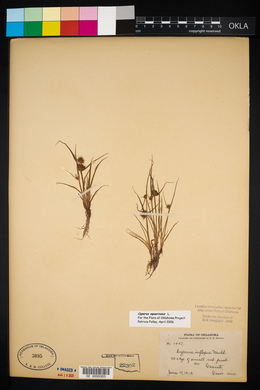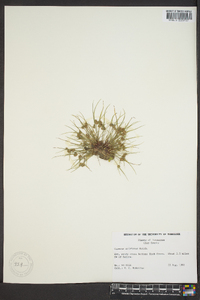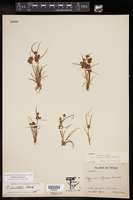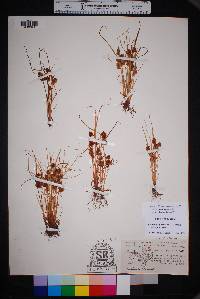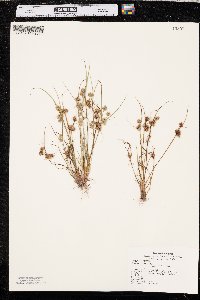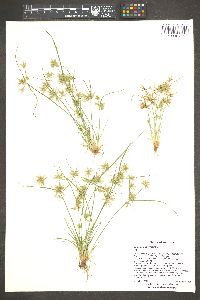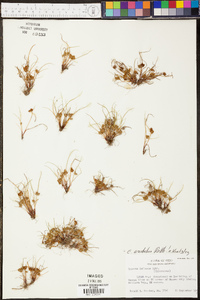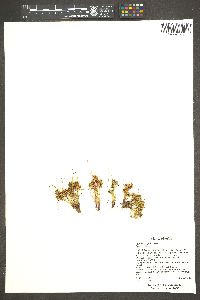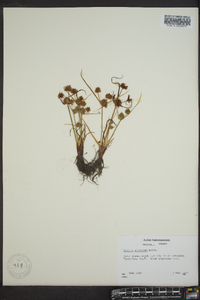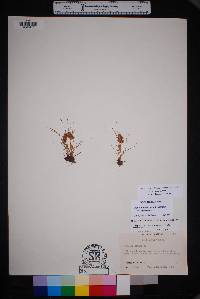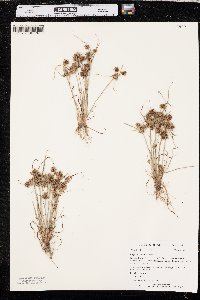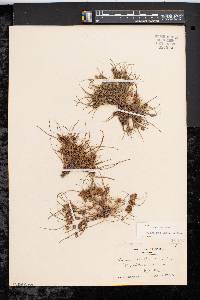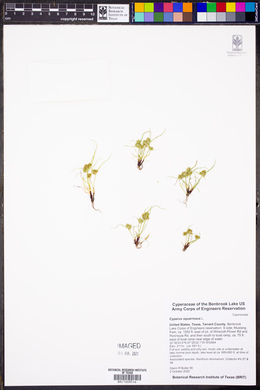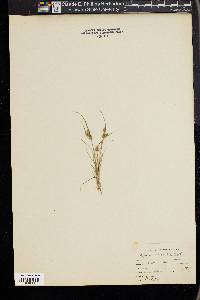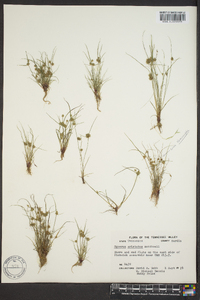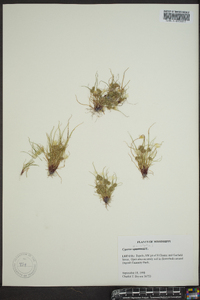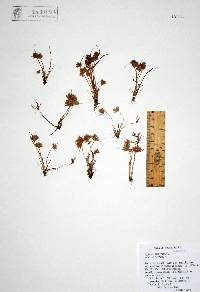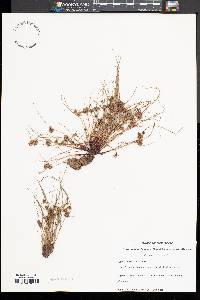Cyperus squarrosus
|
|
|
|
Family: Cyperaceae
Awned Flat Sedge, more...bearded flatsedge, bearded nutgrass (es: tulillo)
[Cyperus aristatus Rottb., moreCyperus aristatus var. aristatus , Cyperus aristatus var. inflexus (Muhl.) Kük. in Engl., Cyperus aristatus var. runyonii O'Neill, Cyperus inflexus Muhl., Cyperus squarrosus var. runyonii (O'Neill) S.D. Jones & J. Wipff, Mariscus squarrosus (L.) C.B.Clarke] |
Herbs, annual, cespitose, with fibrous roots. Culms 1-20, trigonous, 2-16 cm × 0.5-0.8 mm, glabrous. Leaves 1-3, flat to V-shaped, (1-)5-10(-15) × 0.5-2.5 mm. Inflorescences: spike 1, loosely to densely ovoid to oblong, 6-20(-40) × 9-15(-20) mm; rays absent or 1-3(-6), 4-40 mm; bracts (1-)2-4, longest ± erect, V-shaped, 1-15 cm × 0.5-3 mm; rachilla ± deciduous, wingless. Spikelets (2-)6-20(-40), greenish to reddish brown, somewhat compressed, ovoid-lanceoloid to oblong, 2.5-10(-20) × 1.3-2.2 mm (excluding awns); floral scales deciduous, (4-)10-20(-34), greenish to stramineous or brownish red laterally, greenish medially, (5-)7-9(-11)-ribbed nearly to margins, oblong-lanceolate, (1.2-)1.3-1.8(-2.2) × (0.5-)0.7-0.8(-1) mm, apex cuspidate, excurved awn additional 0.5-1(-1.3) mm. Flowers: stamen 1, filaments 1.5 mm; anthers oblong, 0.2-0.3 mm, connective apex reddish, minute; styles 0.3-0.5 mm; stigmas 0.4-0.7 mm. Achenes light brown to nearly black, stipitate, obovoid (occasionally linear-spatulate or linear oblong, infrequently constricted in middle), 0.7-0.8(-1.1) × (0.2-)0.3-0.4(-0.5) mm, stipe 0.05-0.1 × 0.1 mm, apex truncate, apiculate, surfaces papillose. Fruiting summer. Moist, disturbed soils, gravelly roadsides, flood plains, edges of puddles, muddy places; 0-2500 m; Alta., B.C., Man., N.B., Ont., Que.; Ala., Ariz., Ark., Calif., Colo., Conn., Del., D.C., Fla., Ga., Idaho, Ill., Ind., Iowa, Kans., Ky., La., Maine, Md., Mass., Mich., Minn., Miss., Mo., Mont., Nebr., Nev., N.H., N.J., N.Mex., N.Y., N.C., N.Dak., Ohio, Okla., Oreg., Pa., R.I., S.C., S.Dak., Tenn., Tex., Utah., Vt., Va., Wash., W.Va., Wis., Wyo.; Mexico; West Indies; Bermuda; Central America; South America; Eurasia; Africa; Atlantic Islands; Indian Ocean Islands; Pacific Islands; Australia. Cyperus squarrosus can be recognized by its small size and annual habit combined with its oblong-lanceolate floral scales bearing five to eleven conspicuous ribs and excurved awns. Some collections have been misidentified as C. acuminatus, an annual species of subg. Pycnostachys that has ovate-lanceolate, three-ribbed floral scales and digitately clustered spikelets.
Annual herb with fibrous roots, tufted 2 - 16 cm tall Leaves: one to three, basal, alternate, 0.5 - 1 cm long, 0.5 - 2.5 mm wide, flat or V-shaped in cross-section, linear, parallel-veined, keeled beneath, with a sheathing base that encloses the stem. Inflorescence: a single terminal spike, 0.5 - 2 cm long, 9 - 15 mm wide, loosely to densely egg-shaped or oblong, consisting of six to twenty spikelets, subtended by spirally arranged leafy bracts. Bracts two to four, more or less upright, unequal, 1 - 15 cm long, 0.5 - 3 mm wide, all or some much longer than the inflorescence, V-shaped in cross-section. Rays (branches of inflorescence) zero or one to three, 0.5 - 4 cm long. Flowers: minute, in the axil of a floral scale, lacking sepals and petals. Stamen one, exserted, about 1.5 mm long. Anther under 0.5 mm long. Pistil one. Style and stigma about 0.5 mm long. Fruit: a one-seeded achene, short-stalked, light brown to almost black, to about 1 mm long and 0.5 mm wide, usually egg-shaped with a flat apex bearing a short point, three-angled, bumpy. Seed with a thin, non-adherent wall. Spikelets: greenish to reddish brown, 2.5 - 10 mm long, 1 - 2.5 mm wide, somewhat flattened, egg- lance-shaped to oblong, subtended by two small bracts, with ten to twenty floral scales. Scales greenish down the middle, greenish to straw-colored or reddish brown along the sides, about 1.5 mm long and 0.5 mm wide, narrowly lance-shaped with a pointed apex bearing a 0.5 - 1 mm long bristle, seven- to nine-ribbed, lowest one empty. Culms: one to twenty, 2 - 16 cm long, about 0.5 mm wide, triangular in cross-section, solid. Similar species: No information at this time. Flowering: mid-July to late September Habitat and ecology: Mud and gravel bars in streams and in ditches. Occurence in the Chicago region: native Etymology: Cyperus is the ancient Greek word for sedge. Squarrosus means "having parts that are spreading or recurved at the ends." Author: The Morton Arboretum FNA 2002, Tucker 1994 Common Name: bearded flatsedge Duration: Annual Nativity: Native Lifeform: Graminoid General: Caespitose annual 2-16 cm tall, without rhizomes but with fibrous roots. Vegetative: Culms 0.5-1 mm in diameter, three ranked; 1-3 leaves, 5-10 mm long, 0.5-2.5 mm wide, flat to v-shaped, margins smooth. Inflorescence: Bracts 2-4, 1-15 cm long, 0.5-3 mm wide, v-shaped, margins and keels smooth or sparsely rough to the touch, the longest more or less erect, other oblique; spikes 6-20 mm long, 9-15 mm wide, loosely to densely ovoid to oblong, compressed, zigzag, reddish brown; greenish to brownish red; scales deciduous 10-20, 1-2 mm long, oblong-lanceolate, 7-9 nerved nearly to margins. Ecology: Found on disturbed soils, gravelly roadsides, floodplains, mud places from sea level to 8,000 ft (2438 m); flowers July-November. Distribution: Throughout N. Amer and in every state in the US; south through MEX to s S. Amer.; also in Africa, Asia and Australia. Notes: Distinguished its small size, annual habit; ability to grow in the uplands or wet areas; and its oblong-lanceolate floral scales bearing five to eleven conspicuous and excurved awns. Ethnobotany: The tubers were eaten as food. Etymology: Cyperus is from the Greek word meaning sedge, while squarrosus means either scaly or rough. Synonyms: Cyperus aristatus, Cyperus aristatus var. runyonii, Cyperus inflexus, Cyperus squarrosus var. runyonii Editor: SBuckley 2010, FSCoburn 2015 Slender, tufted, sweet-scented annual 0.5-2 dm; lvs few, all borne near the base, mostly 0.5-2(-2.5) mm wide, up to as long as or a little longer than the stems; invol bracts elongate, some or all of them much surpassing the infl; spikelets in dense, capitate clusters, the terminal cluster sessile, the others (if present) on slender rays to 3 cm; spikelets 4-10 mm, flattened, 6-20-fld; scales evidently (5)7-9-nerved, 1.0-1.7 mm exclusive of the recurved, slender awn-tip, this 0.3-1 mm; rachilla wingless, ±persistent, the scales falling from it at maturity; stamen 1; anthers 0.2-0.3 mm; achenes trigonous, 0.6-1 mm; 2n=48, 56, 64. Moist or wet, often sandy soil; nearly cosmop., and throughout our range. (C. aristatus; C. inflexus) Gleason, Henry A. & Cronquist, Arthur J. 1991. Manual of vascular plants of northeastern United States and adjacent Canada. lxxv + 910 pp. ©The New York Botanical Garden. All rights reserved. Used by permission. From Flora of Indiana (1940) by Charles C. Deam Infrequent in wet, sandy or muddy soil on bars in streams and ditches and on the shores of lakes and borders of sloughs. Specimens of this species when dried have a pleasing odor, similar to that of dried slippery elm leaves. |
|
|
|

